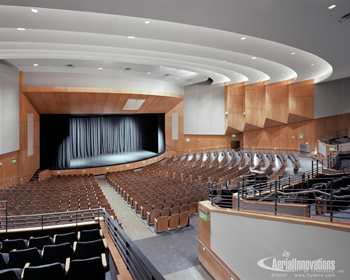
Following the renovation, Langford Auditorium can now handle more options for stage sets and productions.
Upgrades take Langford to next level
After undergoing a complicated renovation, the project to remodel Langford Auditorium is nearing completion.
According to Bobby Otten, architect and planner with Vanderbilt Medical Center's Office of Space and Facilities Planning, all work was performed with no lost work time due to accidents and within the project's estimated total budget of $5.5 million.
In an effort to reduce waste and costs, all existing seats were repainted and reupholstered. The auditorium's original seat count was 1,140. However, the facility's new seat count totals 1,106 after remodeling, having lost 34 seats as a result of renovation.
The building's renovation was complex. The design and construction team consisted of many Vanderbilt representatives and outside partners including Donald Blair Partners, Turner Universal and a wide array of specialists such as a lighting designer, an acoustical consultant, a mechanical engineer, a structural engineer and a theatrical consultant.
As a result of the remodel, Langford now has the ability to handle more options for stage sets and theatrical productions, and has increased stage lighting capabilities.
The venue has a new heat and air system and other improvements such as reconfigured side walls and sound insulation along mechanical separation walls.
These improvements have reduced the auditorium's overall ambient sound level to approximately half its pre-construction level.
All interior finishes are new, and new walls have been designed and constructed with materials and methods that optimize the acoustical performance of the facility.
Langford also features the following new enhancements: audio and visual system, stage flooring and curtains, electrical and emergency power systems, fire suppression system, a wood proscenium to frame the stage, new doors, improved accessibility to the facility for people with disabilities, lighting paired with a touch-screen dimming package, restrooms within the lobby space, dressing rooms, storage areas and loading zone for auditorium performers and auditorium facility managers.













